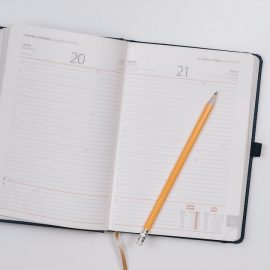

This article is an excerpt from the Shortform book guide to "The Memory Book" by Harry Lorayne and Jerry Lucas. Shortform has the world's best summaries and analyses of books you should be reading.
Like this article? Sign up for a free trial here.
Do you have a speech or presentation coming up? Do you want to deliver it without sounding like you’re reading from a script?
The Memory Book shows you how to remember sequences of items using image-based association, how to create stand-in words to make abstract items easier to remember, and how to apply those techniques to remember full ideas in sequence. You can use these strategies to memorize a speech or presentation.
Continue reading to learn how to remember a speech with techniques from The Memory Book.
How to Remember a Speech
According to authors Harry Lorayne and Jerry Lucas, you can apply the skills of creating image-based associations and using stand-in words or phrases to remember ideas in sequence. This is useful when memorizing a speech. And, not only will you learn how to remember a speech, but you can use the same techniques to remember new concepts from a textbook or any number of places.
This technique entails three steps. Let’s take a look at each one.
(Shortform note: If you need to learn a collection of ideas but not necessarily in sequence, create concept maps to help with memorization. Write key ideas from whatever you’re trying to memorize in bubbles or clouds, then draw arrows that represent connections between the different ideas. Alongside the arrows, write cues that tell you how the ideas relate to each other. This helps with memorization by prompting you to engage deeply with the material, organize the information spatially, and consider the ideas in a relational context. All of these actions improve memory storage and retrieval.)
Step 1: Write Down the Text You Need to Memorize
The authors assert that the first thing to do when memorizing a sequence of ideas is to write down everything you want to remember. Incorporate all your key points in the right order. For example, if you’re writing a speech or preparing for a presentation, write your script. Reading this will give you a general sense of the points you need to remember and how they fit together.
(Shortform note: Some public speaking experts suggest foregoing a script and sticking with just an outline for your speeches and presentations. The text of the outline shouldn’t be a write-up of everything you might say, but rather a loose map of the major points you need to hit. This will help you focus on remembering ideas instead of specific language (as Lorayne and Lucas advise later on). Keep working on your outline until it’s as concise as possible—it should be small enough to fit on an index card. Use the index card as a cheat sheet during your presentation just in case there’s something you forget.)
Step 2: Choose a Core Word or Phrase for Each Idea
After you write down your sequence of ideas in a script or some other form, choose a core word or phrase from each idea that’ll remind you of its main point. By recalling ideas with a single word or phrase, you don’t have to memorize sentences and paragraphs word for word.
(Shortform note: If you have trouble coming up with your core words and phrases, consider asking someone else for their input. Have them read the ideas and describe each one using one word. Their choice may not be exactly what you were thinking, but an outside perspective can prompt discussion that helps you narrow down what you’re trying to convey with each point. The better you know the ideas, the stronger your memorization of them will be.)
Lorayne and Lucas state that when you memorize longer pieces of text word for word, you risk appearing too stiff and formulaic when you deliver the ideas. Likewise, trying to recall text word for word (instead of memorizing general ideas) may make you stumble if you can’t remember the exact right phrasing.
No matter what your subject is, if you’ve studied and practiced enough, you should be able to talk about it using just your core word or phrase as a reminder—without needing to explain it using the same words every time. Repeat this step for every distinct idea or point in your text.
For example, say you’re preparing a talk about fungi and you need to memorize the following idea: “The largest living organism in the world is a fungus called Armillaria solidipes, otherwise known as honey fungus.”
Instead of memorizing the exact words of the sentence, pick one word or phrase (such as “honey fungus”) to remind you of its content. “Honey” is a good option as a core word for this idea because it’ll remind you of the specific fungus that’s the subject of the unusual and interesting fact.
| Tips for Speaking Spontaneously Memorizing ideas instead of text requires you to speak spontaneously, as you’ll need to conjure up a full explanation of each idea on the spot. The following tips from public speaking experts can help you speak spontaneously with confidence: Tip #1: Frame your ideas as a story or include personal stories in your explanation. Then, practice telling your stories in front of people in different ways (switching up the order of the story progression, using different language each time, and so on). Effective storytelling creates connection and flow in a presentation, and practicing variations of stories in front of people allows you to gauge different reactions and determine the best way to construct the narrative. Tip #2: Use verbal “bullet points” while you’re talking to keep track of your ideas. For example, if you’re offering three reasons to support a claim, use transition words like “first,” “additionally,” and “finally” to separate the reasons. This keeps you on track and prevents your ideas from becoming a difficult-to-follow stream of consciousness. |
Step 3: Create a Sequence of Associations Between the Core Words and Phrases
Once you’ve chosen a core word or phrase for each idea, Lorayne and Lucas describe how to use the skills outlined in the first two techniques to create associations between the ideas in your text. These associations help you remember the sequence of your ideas in the correct order.
As we did with the list of words in Technique #1, create associations between the core words or phrases you chose using strange, silly images. If your core word or phrase of an idea can’t be pictured easily on its own, add the extra step of creating a stand-in word or phrase that you can create a mental picture for.
Shortform Example: Discussing the Honey Fungus
Consider our previous example about the honey fungus—you know your first idea’s core word is honey. Now, memorize the next two ideas:
Idea 2: “This fungus’s network includes mushrooms that are visible aboveground and mycelia that branch underground.” Your core word for this idea is network to remind you of the interconnectedness of the aboveground and underground portions of the fungus.
Idea 3: “It spans an area of over three square miles.” For this idea, your core word is area to remind you to discuss the size of the fungus.
Before you create associations between your three core words, decide if you need any stand-in words or phrases to make your mental pictures. You can picture honey on its own, and you picture a fisherman working by throwing a net to remember network. Area, however, is too abstract to imagine on its own. Therefore, you use the similar-sounding word “aria” as a stand-in and create a mental picture by imagining an opera singer singing a solo.
Finally, you create your image-based associations for honey, network, and aria, connecting them in that order. First, you construct a silly image to connect honey and network by imagining a fisherman casting a net into an ocean filled with honey instead of water. Then, you connect network and aria by imagining a fisherman casting a net to capture fish that are singing opera music.
| Use Drawing to Help You Remember Your Associations As you combine all the steps from Lorayne and Lucas’s previous techniques—association images, core words, and stand-in words—the information you must memorize may feel like too much to keep track of. To solidify each step in your memory, consider keeping track of the words and images you come up with by drawing them. Draw an image for each core word (or their more easily pictured stand-in word) in the right order, then draw scenes that represent your associations between the words. Some researchers suggest that drawing may be more effective for memorization than any other method of putting information onto paper (like writing). First, drawing requires you to think about the meaning of your subject and how to translate it from language to imagery. Additionally, it involves motor action as you move your hands and visual processing as you create the picture. These varying sensory experiences create more connections in your brain than just thinking about the information, making it more likely you’ll remember it. |

———End of Preview———
Like what you just read? Read the rest of the world's best book summary and analysis of Harry Lorayne and Jerry Lucas's "The Memory Book" at Shortform.
Here's what you'll find in our full The Memory Book summary:
- How to improve your memorization skills and recall any kind of information
- Techniques for remembering sequences of information
- How to picture and remember abstract information






